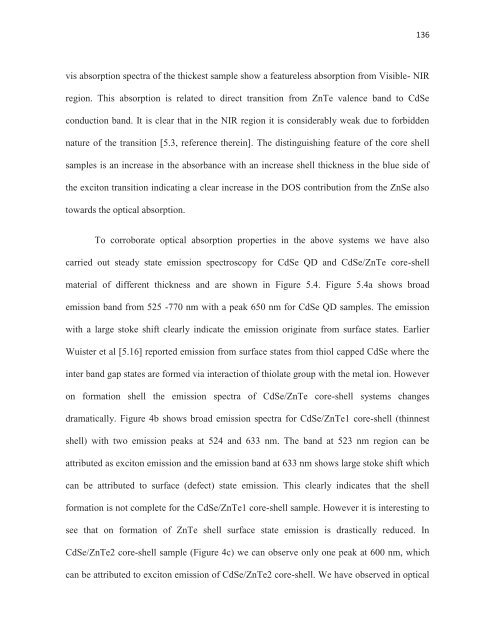CHEM01200604009 Sreejith Kaniyankandy - Homi Bhabha ...
CHEM01200604009 Sreejith Kaniyankandy - Homi Bhabha ...
CHEM01200604009 Sreejith Kaniyankandy - Homi Bhabha ...
You also want an ePaper? Increase the reach of your titles
YUMPU automatically turns print PDFs into web optimized ePapers that Google loves.
136<br />
vis absorption spectra of the thickest sample show a featureless absorption from Visible- NIR<br />
region. This absorption is related to direct transition from ZnTe valence band to CdSe<br />
conduction band. It is clear that in the NIR region it is considerably weak due to forbidden<br />
nature of the transition [5.3, reference therein]. The distinguishing feature of the core shell<br />
samples is an increase in the absorbance with an increase shell thickness in the blue side of<br />
the exciton transition indicating a clear increase in the DOS contribution from the ZnSe also<br />
towards the optical absorption.<br />
To corroborate optical absorption properties in the above systems we have also<br />
carried out steady state emission spectroscopy for CdSe QD and CdSe/ZnTe core-shell<br />
material of different thickness and are shown in Figure 5.4. Figure 5.4a shows broad<br />
emission band from 525 -770 nm with a peak 650 nm for CdSe QD samples. The emission<br />
with a large stoke shift clearly indicate the emission originate from surface states. Earlier<br />
Wuister et al [5.16] reported emission from surface states from thiol capped CdSe where the<br />
inter band gap states are formed via interaction of thiolate group with the metal ion. However<br />
on formation shell the emission spectra of CdSe/ZnTe core-shell systems changes<br />
dramatically. Figure 4b shows broad emission spectra for CdSe/ZnTe1 core-shell (thinnest<br />
shell) with two emission peaks at 524 and 633 nm. The band at 523 nm region can be<br />
attributed as exciton emission and the emission band at 633 nm shows large stoke shift which<br />
can be attributed to surface (defect) state emission. This clearly indicates that the shell<br />
formation is not complete for the CdSe/ZnTe1 core-shell sample. However it is interesting to<br />
see that on formation of ZnTe shell surface state emission is drastically reduced. In<br />
CdSe/ZnTe2 core-shell sample (Figure 4c) we can observe only one peak at 600 nm, which<br />
can be attributed to exciton emission of CdSe/ZnTe2 core-shell. We have observed in optical
















